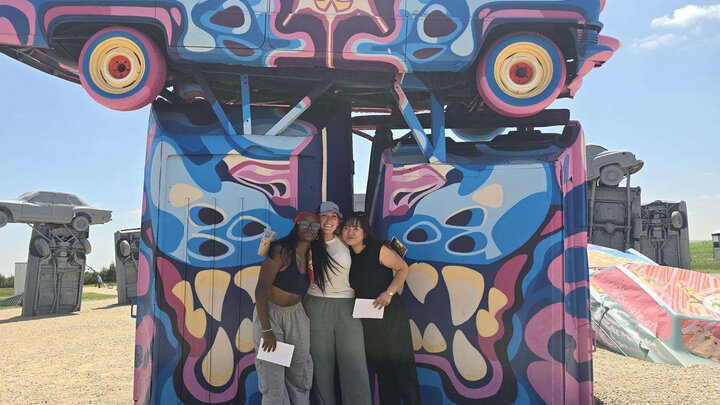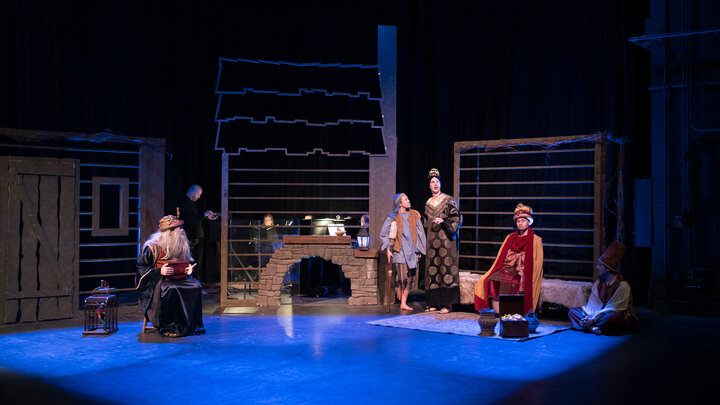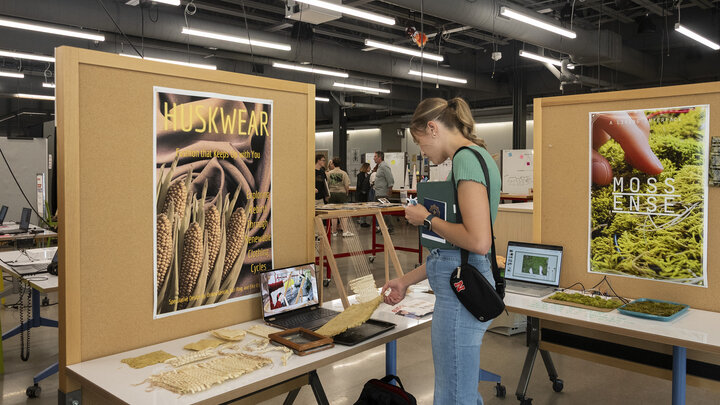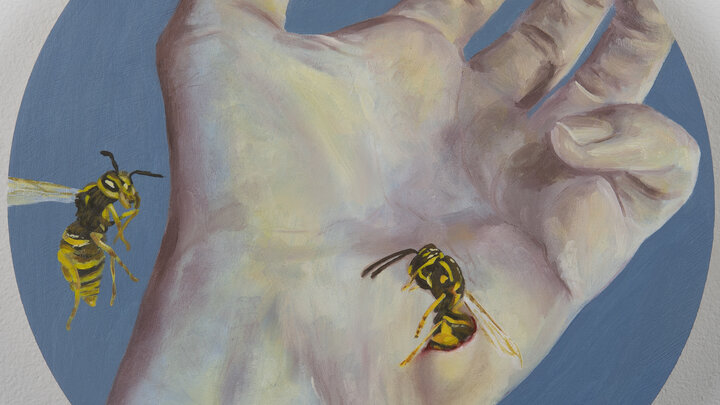Lincoln, Neb.--Two students in the School of Art, Art History & Design participated in the Carhenge Mural Festival in June in Alliance, Nebraska, and earned valuable real-world experience with public art.
As part of the festival, organized by the Alliance Creative District (ACD), eight international artists painted their designated cars at the famous Carhenge, Nebraska’s unique tribute to Stonehenge, while the ACD held concurrent art workshops in various locations throughout the city of Alliance.
“As participants we had the opportunity to assist the artists with their murals by preparing surfaces and attending workshops led by the artists themselves,” said senior art major Amy Xu, who participated along with senior art major Michelle Reese. “Being in the field, witnessing the artists work and interacting with them in real time allowed me to truly appreciate the concept of public art. ‘Street art’ is public and accessible to everyone, but this level of accessibility is often overlooked in academia where we often learn art in terms of galleries or museums.”
The festival was organized by School of Art, Art History & Design alumna Kyren Gibson (B.F.A. 2011), executive director of the Carnegie Arts Center in Alliance.
“We organized the festival to celebrate local creativity, engage the community and boost economic growth by enhancing one of our most unique tourism assets,” Gibson said. “While the festival itself was a meaningful celebration of art and community, our hopes extend far beyond the event. We aim for the festival to reinvigorate Carhenge’s appeal for new and diverse audiences, ultimately boosting tourism, strengthening community pride and helping Alliance attract and retain residents—especially younger generations looking for a vibrant place to call home.”
Xu was impressed with the festival’s impact on the community.
“It was powerful to witness well-known artists brought into a rural town where people may have never had the chance to encounter contemporary street art unless they traveled to a major city,” she said. “Because UNL is funded through a land grant, it was a great opportunity, as a student, to assist in serving local Nebraskans and take part in bringing some unique opportunities out to them. Thanks to our professor, Sandra Williams, she picked Michelle and I to assist in the festival and worked to get grants to aid in us getting some real-world experience within public art.”
Gibson said Xu and Reese were instrumental to the success of the Carhenge Mural Festival.
“They contributed both behind the scenes and through meaningful community engagement,” she said. “From day one, they were on-site assisting muralists by cleaning, scraping and priming 13 car structures at Carhenge—going well beyond the original plan of eight—along with preparing mural walls in town.”
They also led two major outreach projects designed to connect the broader community to the festival.
“At the Alliance Recreation Center, they worked one-on-one with over 50 children (ages 5-10), using stencils Amy had created for the Sidewalk Safari project designed by Professor Sandra Williams,” Gibson said. “Together, they guided the kids in creating layered spray chalk artworks, giving them a sense of ownership and participation in the festival. The next day, Michelle and Amy brought the same creative energy to Highland Park Nursing Home, where they engaged over 20 residents in a stencil art project on the side of a train car. With the help of two muralists, they empowered residents to make their own one-of-a-kind pieces, fostering creativity and joy.”
Xu appreciated the opportunity to work with both young children and seniors in spray paint activities.
“These two vastly different age groups are rarely ever included together in art outreach,” she said. “Spray paint inherently says, ‘I was here,’ and for seniors who are often overlooked and excluded from programs like these, participating in making a train car becomes an act of symbolic visibility. It’s a reminder that street art is not only made for everyone but can be made by anyone.”
Xu said she learned a lot in just a week.
“Within the span of a week, I’ve learned to expand my perspective on art to include audience, visibility and execution,” she said. “Street artists work quickly and effectively and must brave all weather, a testament to the visibility of their work. It is created with the knowledge that it will be viewed and interacted with by the public.”
Xu and Reese also attended artist workshops and worked directly with the muralists.
“Their work helped ensure that the festival wasn’t just something to observe, but something people of all ages could actively be a part of,” Gibson said.
Xu said many of the workshops she attended left her with a deep appreciation of the artists’ work.
“Chanate encouraged thinking beyond the boundaries and planning a large-scale public event, with ideas being limitless,” she said. “Hanna Webb (The Obanoth) was about efficiency, speed and making it easy to get in the studio and make work. It was refreshing and fearless. We broke down our image into shapes and took liberties while staying within the boundaries of concept to not get overwhelmed with perfection and detail.”
Gibson worked closely with them throughout the festival and said their contributions were “absolutely essential.”
“They took on long, labor-intensive days in the heat without hesitation and were also present at community-building events like the artist dinner, star-viewing experience and informal social gatherings,” she said. “Those moments allowed me to connect with them personally and see just how committed and engaged they were. I hope they took away from the experience a deeper understanding of what it really takes to bring a creative project to life—from early mornings to last-minute problem-solving.”
Gibson hopes they grew in confidence as artists.
“Events like this often look polished from the outside, but the behind-the-scenes reality is much messier—and more human,” she said. “I hope they saw that you don’t need to have all the answers or be perfect to be part of something meaningful. You just need to care deeply, be willing to show up, and stay open to learning along the way. That kind of experience can build a lot of confidence, and I truly hope it did for them.”
Gibson said public art projects like this festival are acts of resilience and reinvention for rural communities like Alliance.
“The decline of rural America has been a slow and painful erosion. We’ve watched businesses close, corporate sponsors withdraw support, and young people move away in search of better opportunities,” she said. “It’s clear we need a new approach—one that embraces creativity, innovation and community identity as economic drivers.”
That’s why projects like the Carhenge Mural Festival matter so deeply to communities like Alliance.
“The arts offer more than beauty; they offer possibility,” Gibson said. “Since the days of FDR’s New Deal, we’ve seen how investment in the arts can revitalize towns by creating new industries, boosting local pride and attracting tourism. These are the very goals behind the Nebraska Creative District program, which was established by the Nebraska Arts Council and supported by the Legislature to help communities like Alliance invest in cultural infrastructure and unlock their creative economies. The arts won’t fix everything, but they are one of the few tools we have that can spark real momentum, unify diverse groups and restore a sense of pride and purpose in our shared spaces.”
The collaboration of the town left a lasting impression on Xu.
“Public art, especially in rural areas, deserve more emphasis,” she said. “Not everyone has the resources or ability to visit a gallery or museum, and public art removes that barrier. It’s free, visible and belongs to all.”
Gibson said she appreciates the mentorship Xu and Reese received from Associate Professor of Art Sandra Williams, who also participated in the festival.
“Working with Amy and Michelle during the festival was incredibly meaningful—not only because I saw myself in them, but because I know they’re being mentored by one of the most insightful and forward-thinking educators I’ve known, Professor Sandra Williams,” Gibson said. “During my undergraduate studies at UNL, Sandra’s influence extended far beyond the classroom. She introduced me to the intellectual framework of public art—not simply as an aesthetic practice, but as a powerful tool for community engagement, economic development and cultural empowerment.”
Gibson said Williams didn’t just teach theory. Instead, she brought her students into real-world projects.
“We collaborated with public schools, participated in community events and engaged directly with the public through art. These experiences were formative—grounding academic ideas in practice and guiding me through the process of planning and leading my own community-based projects,” she said. “Her teaching is rooted in a deep understanding of the social function of art. Sandra consistently pushes her students to think critically about the role of artists in shaping public space—how creative work can foster dialogue, reflect identity and build a sense of belonging. Those ideas have stayed with me long after graduation. Just five years later, I found myself serving as the director of the Carnegie Arts Center in Alliance—directly applying the principles Sandra helped me develop.”
Williams said it was an easy decision to help Gibson at the festival.
“If a friend asks for your help, you don’t ask questions. You just get in the car and go,” Williams said. “UNL is a land-grant institution. We still believe in serving our state and the nation through teaching, research and extension activities. And this was a unique collaboration. As Alliance launched its inaugural Creative District event, it allowed students to participate in the power the arts have in reshaping and revitalizing communities.”
Williams said it was an opportunity for Xu and Reese to learn about the role of art in the public sphere.
“I selected Michelle and Amy because, yes, they are extremely talented and dedicated students, but they also possess advanced organizational skills and are adept at seamlessly working with multiple populations,” she said. “Both are chameleons, able to adapt according to the need or demand. Conceptually we discussed issues of audience, who are audience is, and as a visual artist, how do you make your audience visible? What is the role and relationship between artist and audience? How do we make contemporary art germane to daily life? I’m truly grateful that the college and the school supported these women. They found resources to support our students and our rural communities. By participating in this festival, Amy and Michelle got real-world experience with how the arts can shape communities.”
Gibson said Williams has built a legacy of students who don’t just create art but understand its civic and cultural dimensions and use it to affect meaningful change.
“I’m excited for Amy and Michelle because they are receiving that same kind of mentorship—one that bridges creative practice and real-world impact,” Gibson said. “The foundational ideas we’re now building the Creative District around were first introduced to me in Sandra’s classroom. That is a true testament to her ability to prepare students not only for artistic careers, but for leadership roles in shaping vibrant, creative communities.”



